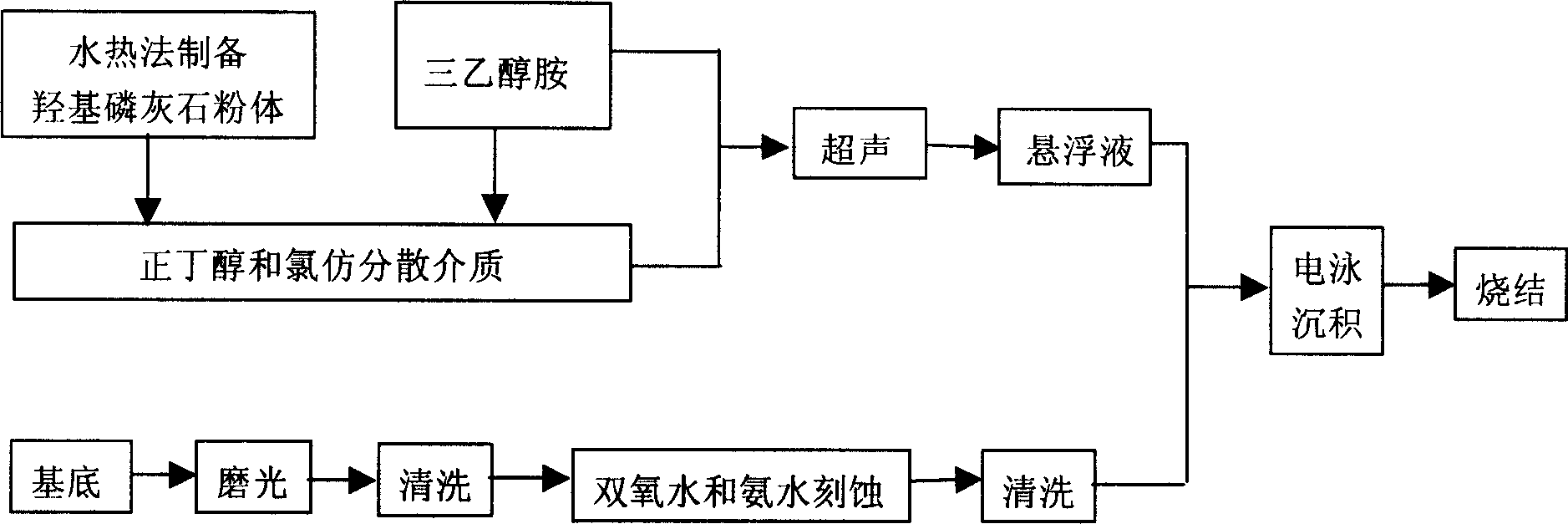Method of preparing electrophoretic deposited hydroxyl apatite coating on Ti or Ti alloy surface
A hydroxyapatite, electrophoretic deposition technology, applied in coatings, electrolytic coatings, electrophoretic plating, etc., can solve the problems of limited application, low bonding strength, etc.
- Summary
- Abstract
- Description
- Claims
- Application Information
AI Technical Summary
Problems solved by technology
Method used
Image
Examples
Embodiment 1
[0020] Preparation of hydroxyapatite powder: add 0.2g (concentration: 8g / L) polyethylene glycol to 25mL 0.5mol / L calcium nitrate solution, stir to dissolve and adjust the pH of the solution to ≥ 11.00 with ammonia water, drop by drop under magnetic stirring Add 25mL, 0.3mol / L, ammonium phosphate solution with pH ≥ 10, and finish adding in about 10 minutes. After standing still, the precipitate and the solution were transferred into a stainless steel autoclave lined with polytetrafluoroethylene, and the autoclave was placed in a constant temperature drying oven for hydrothermal reaction at 200°C for 8 hours. After natural cooling, wash with distilled water twice, then with absolute ethanol, filter with suction, and finally dry at 100°C for 1 hour, weigh about 1.1g of hydroxyapatite powder, and store it in a weighing bottle .
[0021] Preparation of the suspension: Weigh 1g of HAp powder and add it to 50mL of the dispersion medium mixed with n-butanol and chloroform with a volu...
Embodiment 2
[0027] Preparation of hydroxyapatite powder: add 0.2g (concentration: 8g / L) polyethylene glycol to 25mL 0.5mol / L calcium nitrate solution, stir to dissolve and adjust the pH of the solution to ≥ 11.00 with ammonia water, drop by drop under magnetic stirring Add 25mL, 0.3mol / L, ammonium phosphate solution with pH ≥ 10, and finish adding in about 10 minutes. After standing still, the precipitate and solution were transferred into a stainless steel autoclave lined with polytetrafluoroethylene, and the autoclave was placed in a constant temperature drying oven for hydrothermal reaction at 200°C for 6.5 hours. After natural cooling, wash with distilled water twice, then with absolute ethanol, filter with suction, and finally dry at 100°C for 1 hour, weigh about 1.1g of hydroxyapatite powder, and store it in a weighing bottle .
[0028] Preparation of the suspension: Weigh 1g of HAp powder and add it to 50mL of the dispersion medium mixed with n-butanol and chloroform at a volume r...
Embodiment 3
[0034] Preparation of hydroxyapatite powder: add 0.2g (concentration: 8g / L) polyethylene glycol to 25mL 0.5mol / L calcium nitrate solution, stir to dissolve and adjust the pH of the solution to ≥ 11.00 with ammonia water, drop by drop under magnetic stirring Add 25mL, 0.3mol / L, ammonium phosphate solution with pH ≥ 10, and finish adding in about 10 minutes. After standing still, the precipitate and solution were transferred into a stainless steel autoclave lined with polytetrafluoroethylene, and the autoclave was placed in a constant temperature drying oven for hydrothermal reaction at 200°C for 6.5 hours. After natural cooling, wash with distilled water twice, then with absolute ethanol, filter with suction, and finally dry at 100°C for 1 hour, weigh about 1.1g of hydroxyapatite powder, and store it in a weighing bottle .
[0035] Preparation of the suspension: Weigh 1g of HAp powder and add it to 50mL of the dispersion medium mixed with n-butanol and chloroform with a volume...
PUM
| Property | Measurement | Unit |
|---|---|---|
| thickness | aaaaa | aaaaa |
Abstract
Description
Claims
Application Information
 Login to View More
Login to View More - R&D
- Intellectual Property
- Life Sciences
- Materials
- Tech Scout
- Unparalleled Data Quality
- Higher Quality Content
- 60% Fewer Hallucinations
Browse by: Latest US Patents, China's latest patents, Technical Efficacy Thesaurus, Application Domain, Technology Topic, Popular Technical Reports.
© 2025 PatSnap. All rights reserved.Legal|Privacy policy|Modern Slavery Act Transparency Statement|Sitemap|About US| Contact US: help@patsnap.com


